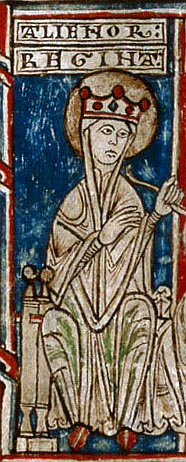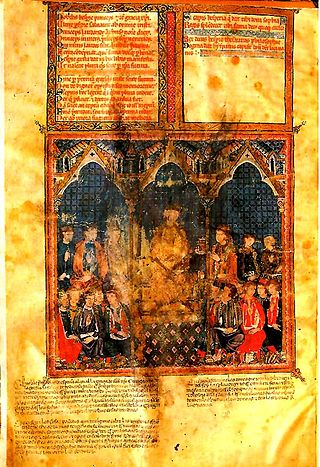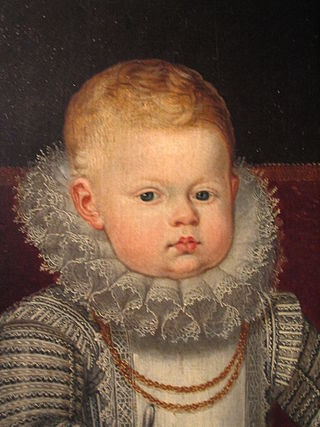Related Research Articles

Pelagius was a Hispano-Visigoth nobleman who founded the Kingdom of Asturias in 718. Pelagius is credited with initiating the Reconquista, the Christian reconquest of the Iberian Peninsula from the Moors, and establishing the Asturian monarchy, making him the forefather of all the future Iberian monarchies, including the Kings of Castile, the Kings of León, and the Kings of Portugal.

Eleanor of England, was Queen of Castile and Toledo as wife of Alfonso VIII of Castile. She was the sixth child and second daughter of Henry II, King of England, and Eleanor of Aquitaine. She served as Regent of Castile during the minority of her son Henry I between the death of her spouse until her own death in 1214.
Pinto is a municipality in the Community of Madrid, Spain. It is located in the central area of the Iberian Peninsula at an altitude of 604 meters, 20 kilometers south of Madrid, and covers 62.7 square kilometers. In 2018, Pinto had a population of 51,541. It is home to the Torre de Pinto, the Pinto Castle, and the Éboli Tower, which is a 14th-century tower used as a prison for nobles who fell out of favor with the king.

Rodrigo Jiménezde Rada was a Roman Catholic bishop and historian, who held an important religious and political role in the Kingdom of Castile during the reigns of Alfonso VIII and Ferdinand III, a period in which the Castilian monarchy consolidated its political hegemony over the rest of polities in the Iberian Peninsula. He was at the helm of the Archdiocese of Toledo from 1208 to 1247. He authored De rebus Hispaniae, a history of the Iberian Peninsula.

De rebus Hispaniae or Historia gothica is a history of the Iberian peninsula written in Latin by Archbishop of Toledo Rodrigo Jiménez de Rada in the first half of the thirteenth century on behalf of King Ferdinand III of Castile.
Francisco de Borja del Paso y Troncoso was an important Mexican historian, archivist, and Nahuatl language scholar. He "was and remains the outstanding major Mexican investigator of his era, a fully accepted figure in the international group of his peers."
The Battle of Lobregal took place in March 1160 between the House of Lara and its allies and the forces of the House of Castro under Fernando Rodríguez de Castro. The battle was the high point of a series of struggles for power between the Lara and Castro families following the death of Sancho III of Castile in August 1158 and the accession of his young son, Alfonso VIII. In 1159 the Lara had seized the regency from Gutierre Fernández de Castro, Fernando's uncle.
The Annales Compostellani or Anales castellanos terceros are a set of Latin annals found in, and named after, Santiago de Compostela. They were found in the manuscript known as the Tumbo negrode Santiago de Compostela, but they were originally redacted in the Rioja. They are grouped with the Chronicon Ambrosianum and the Chronicon Burgense as the Efemérides riojanas. They cover the history of the County and Kingdom of Castile and the Kingdom of Navarre until the reconquest of Seville in 1248.
The Anales castellanos segundos are a set of Latin annals compiled in the mid or late twelfth century in Castile, covering the period from the nativity of Jesus to the death of Queen Urraca in 1126 or to 1110. It is preserved in a thirteenth-century manuscript now in the Leiden Universiteitsbibliotheek, shelfmark VLO 91. This manuscript was kept at the University of Alcalá de Henares until at least the sixteenth century and thus the annals were known as the Annales Complutenses.
On 1 March 1143 the Battle of Montiel was fought between Muño Alfonso and an army of knights from Ávila, Segovia, and Toledo on one side and a force of Almoravids on the other. The Christians were accompanied by priests. It was a decisive victory for Muño.
The Chronicon Burgense is a collection of Latin annals that, together with the Annales Compostellani and the Chronicon Ambrosianum, may form a group of related histories sometimes called the Efemérides riojanas because they may have been compiled in La Rioja. The Chronicon Burgense is named after the Cathedral of Burgos, where it was discovered on one folio of a surviving thirteenth-century obituary/calendar. It deals primarily with matters in the Kingdom of Castile and may have been written at Burgos, the Castilian capital. It also touches on the Kingdom of Navarre and covers the period from the Nativity of Jesus to the Battle of Las Navas de Tolosa in 1212. It uses the dating system of the Spanish era and not the Anno domini. It is a unique source for several details relating to early Castilian history. The following is an excerpt:
Era MCXV. Fuit hiems gravissima a festivitate S. Martini usque ad Quadragesimam, & in ipso anno pugnaverunt duo milites pro lege Romana, & Toletana in die Ramis palmarum, & unus eorum erat Castellanus, & alius Toletanus, & victus est Toletanus a Castellano.
1077 AD. It was a severe winter from Martinmas until Quadragesima. And in that year fought two knights [one] for the Roman Rite and [one for] the Mozarabic Rite on Palm Sunday. And one of these [the former] was a Castilian and the other a Toledan. And the Toledan was victorious over the Castilian.

The Estoria de España, also known in the 1906 edition of Ramón Menéndez Pidal as the Primera Crónica General, is a history book written on the initiative of Alfonso X of Castile "El Sabio", who was actively involved in the editing. It is believed to be the first extended history of Spain in Old Spanish, a West Iberian Romance language that forms part of the lineage from Vulgar Latin to modern Spanish. Many prior works were consulted in constructing this history.
The Battle of Huete took place in 1164 between the Lara family and its allies, and the Castro family and its supporters. It was part of the civil war which engulfed the Kingdom of Castile following the death of Sancho III (1158), wherein competing factions sought control of his minor son and successor, Alfonso VIII. In 1162 the same two factions had met at the Battle of Lobregal. At Huete the Lara leaders were the three brothers Manrique, Nuño, and Álvaro Pérez de Lara. The Castro were led by Fernando Rodríguez de Castro, who had been in exile at the court of Ferdinand II of León since 1160.
The Chronicon complutense sive alcobacense is a short medieval Latin history, in the form of annals, of events in Galicia and Portugal up to the death of Ferdinand I "the Great", whom the anonymous chronicler lauds as an "exceedingly strong emperor", in 1065. It is the earliest "chronicon" dealing with Galaico-Portuguese events. The first edition was published by Enrique Flórez in 1767. A more recent edition, incorporating the recension known as the Chronicon conimbrigense, was published under the title Annales Portugalenses veteres by Pierre David.
Caliabria was a city and the seat of a diocese founded in the 7th century in Visigothic Spain and is now a Latin titular see of the Catholic Church.

The Guadyerbas is a river of Spain located in the centre of the Iberian Peninsula. It is the main left-bank tributary of the Tiétar, in turn a major tributary of the Tagus.
Melantius was a Romano-Hispanic Bishop of Toledo from the end of the 3rd Century to the beginning of the 4th century, whose name only appears in the minutes of the Synod of Elvira in contemporary sources.

Margarita of Spain was an infanta of Spain, who died in childhood.

Alonso of Spain was an infante of Spain, who died in childhood.

The Campo de San Juan was the seigneurial lordship of the Order of St. John in the lands of La Mancha. It was the most important possession of the Grand Priory of the langue of Castile and León. It spanned across territory of the current Spanish provinces of Toledo and Ciudad Real. The most important urban centres were Consuegra and Alcázar de San Juan.
References
- Porter Conerly (1993). "Cronicones". In Germán Bleiberg. Dictionary of the Literature of the Iberian Peninsula. Greenwood Publishing Group. pp. 469–70.
- Gonzalo Martínez Díez (2005). El condado de Castilla, 711–1038: La historia frente a la leyenda. Marcial Pons Historia. p. 755.